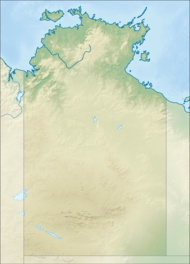Native Gap Conservation Reserve
| Native Gap Conservation Reserve Northern Territory | |
|---|---|
IUCN category V (protected landscape/seascape)[1] | |
 Sandstone Ridge at Native gap | |
| Coordinates | 22°48′00″S 133°25′00″E / 22.80000°S 133.41667°E |
| Established | 26 May 1980[1] |
| Area | 11 hectares (27 acres)[1] |
| Managing authorities | Parks and Wildlife Commission of the Northern Territory |
| See also | Protected areas of the Northern Territory |
Native Gap Conservation Reserve is a protected area in the Northern Territory of Australia.
It is located approximately 115 kilometres (71 mi) north of Alice Springs and 1,380 kilometres (857 mi) south of Darwin. The park is found just off along the Stuart Highway on the western side, via an unsealed track to a telecommunications tower in the nearby Hann Range.
The traditional owners of the area are the Arrente and Anmatyerr peoples, to whom it is a sacred site.[2] The area is at the junction of many creation stories, and the name of the site in the Arrente dialect is Arurlte Artwatye, where Arurlte means "the top of the shoulders across the neck" and Artwatye means "gap".[2]
The name of the site is derived from the 30 metres (98 ft) sandstone ridge that dominates the reserve standing above the surrounding Burt Plain.[3]
The name of the area was first used in 1872 when one of the builders of the Overland telegraph, W. W. Mills, reported to Charles Todd that they had come to a "Native Gap". He wrote of a "native well" that was situated in a gap in Hann's Range. The gap is thought to have taken the name of the well it contained.[4]
In 1880 workers on the telegraph widened the gap by blasting the rock with explosives but in doing so destroying the water-holding rocks.[5]
Flora found at the reserve include the native fig, white cypress pine found up on the ridge[4] along with shrubs including Acacia monticola and Acacia melleodora, Eucalyptus gamophylla, and Eucalyptus sessilis also grow on top of the ridge even in the most exposed areas.[6] ironwood, desert bloodwood and ghost gums[4] on the sandy flats.[3] Desert grasses and spinifex are found throughout the reserve, with Drosera growing on the flats after rain.[7] Other plants found through the reserve include Grevillea wickhamii and some Gossypium species
Birdlife found on the reserve include western bowerbirds that feed on the native fig, little woodswallows, dusky grasswrens among the spinifex and brown quail after wet seasons.[7] Other species found include whistling kite, rainbow bee-eater, willie wagtail, inland thornbill, variegated fairywren, mistletoebird, grey-headed honeyeater and Torresian crow.[6]
Other fauna found on the reserve include the short-beaked echidna, euro and the black-footed rock-wallaby.[4]
See also
[edit]Protected areas of the Northern Territory
References
[edit]- ^ a b c "Terrestrial Protected Areas by Reserve Type in the Northern Territory (2012)". Department of Environment. 2012. Retrieved 18 April 2015.
- ^ a b "Native Gap Conservation Reserve". Explore Australia's Outback. Retrieved 18 April 2015.
- ^ a b "Native Gap Conservation Reserve". Parks and wildlife Commission. Retrieved 18 April 2015.
- ^ a b c d "Fact Sheet - Native Gap" (PDF). Northern Territory Government. Archived from the original (PDF) on 28 February 2015. Retrieved 18 April 2015.
- ^ "Alice Springs to Tennant Creek - A journey through the centre of Australia". Australia so much to see. Retrieved 18 April 2015.
- ^ a b "Alice Springs Field Naturalists Club Newsletter" (PDF). November 2009. Retrieved 19 April 2015.
- ^ a b "Native Gap". Alice Springs Field Naturalists. Retrieved 18 April 2015.


 French
French Deutsch
Deutsch